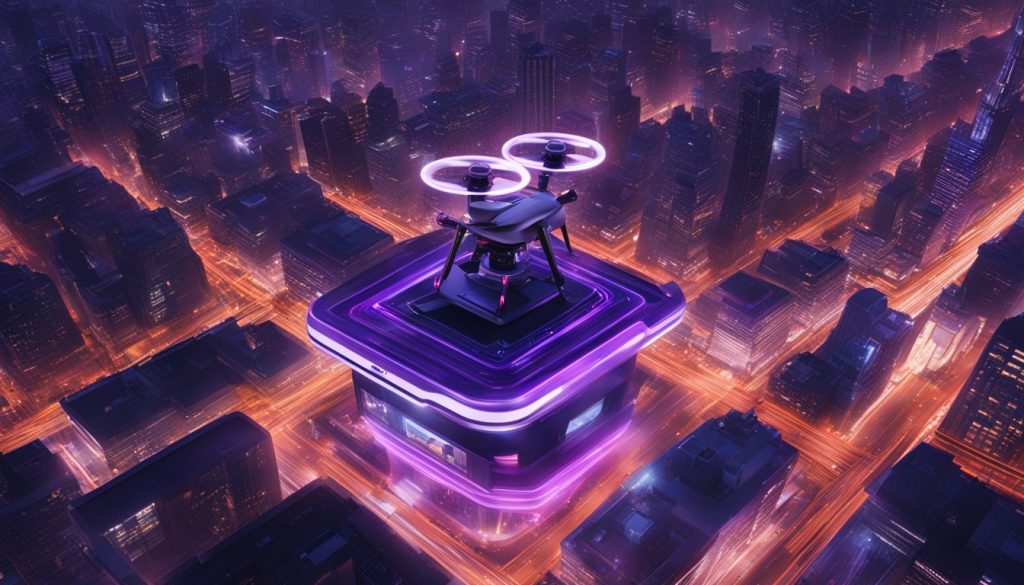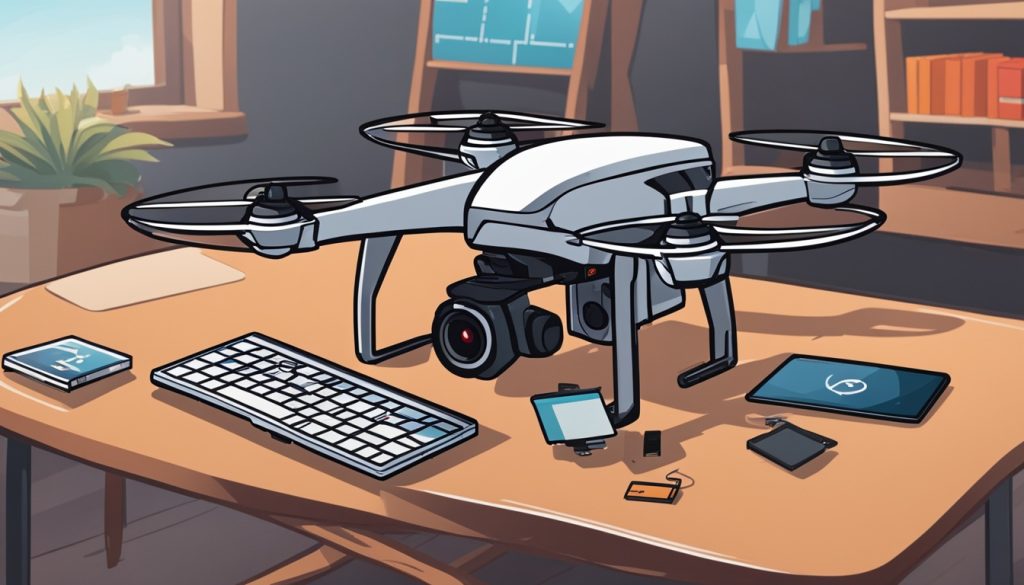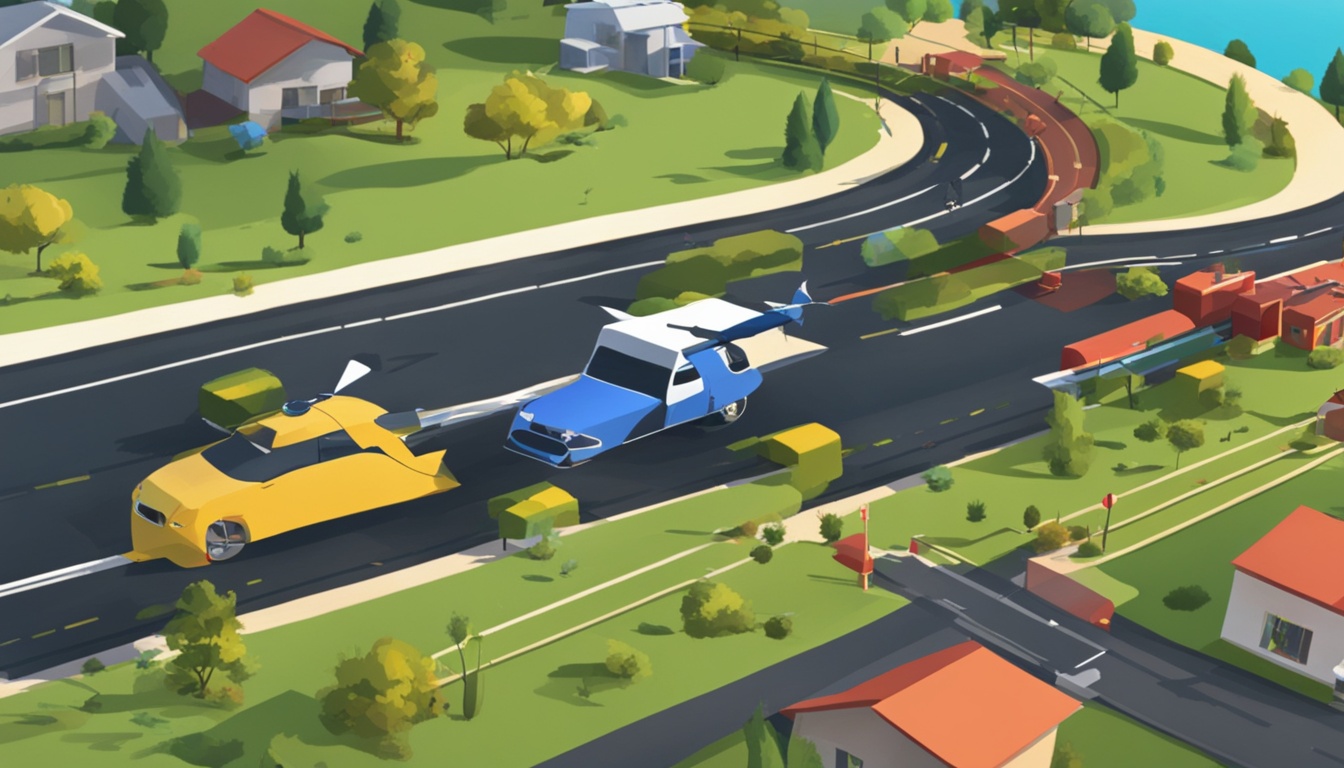Mastering timeline manipulation can make your drone edits look amazing. This method in aerial cinematography turns regular drone footage into fast-paced, captivating stories. It’s a way to tell stories from above in a new way.
Hyperlapse video editing blends time-lapse with drone footage for stunning aerial shots. It takes photos while flying slowly and then puts them together. This makes it seem like the drone is moving fast, while the ground below is moving even faster.
Creating a hyperlapse takes a lot of planning and skill. You need the right gear, to manage your files well, and to edit your photos. It’s a lot of work, but the final result is amazing. It gives viewers a unique view of the world moving fast.
Understanding Hyperlapse Drone Photography
Hyperlapse drone photography combines aerial time-lapse with motion for dynamic footage. It turns ordinary scenes into captivating visuals by making movement more dramatic. Let’s explore the basics of this innovative drone photography method.
Hyperlapse techniques focus on picking subjects with lots of motion. Great choices include busy highways, flowing water, or clouds moving over cities. The goal is to capture scenes that change over time, making your aerial time-lapse stories come alive.
To get good at drone photography basics for hyperlapse, plan well and pick the right subjects. These steps are key for making unique and interesting sequences. Think about lighting, traffic, and nature when picking your spot and time to shoot.
| Hyperlapse Element | Importance | Example |
|---|---|---|
| Subject Motion | High | Rush hour traffic |
| Camera Movement | Medium | Slow ascent or orbit |
| Time Frame | High | Sunset to twilight |
| Frame Rate | Medium | 1 frame per 2 seconds |
Understanding these key points will help you start with hyperlapse drone photography. Remember, practice and patience are essential. They will help you master this exciting technique and create amazing aerial time-lapse videos.
Essential Equipment for Hyperlapse Drone Edits
To make stunning hyperlapse drone edits, you need the right gear and tools. Let’s look at the key drone equipment, camera gear, and video editing software. These are what you’ll need to capture and make amazing aerial timelapses.
Choosing the Right Drone
Choosing a good drone is key for hyperlapse photography. DJI drones like the Mavic 2 Pro have built-in hyperlapse features. They are a top pick. Think about flight time, stability, and camera quality when picking your drone.
Camera and Lens Selection
The camera you pick affects the final look. You can choose from drone cameras, GoPros, or DSLRs. For special effects, some use modified lenses for a tilt-shift look. Pick your camera based on your vision and needs.
Necessary Software Tools
Creating hyperlapses needs both planning and editing software. Apps like Litchi or Mission Planner help plan your flight. For editing, use professional video editing software like Adobe After Effects for stabilization and final touches.
| Equipment Type | Examples | Key Features |
|---|---|---|
| Drones | DJI Mavic 2 Pro, Phantom 4 Pro | Built-in hyperlapse modes, long flight times |
| Cameras | Integrated drone cameras, GoPro, DSLR | High resolution, manual controls |
| Software | Litchi, Mission Planner, Adobe After Effects | Flight planning, video stabilization, editing |
With the right drone equipment, camera gear, and video editing software, you’re set to make captivating hyperlapse drone edits. These edits will surely impress your audience.
Planning Your Hyperlapse Shot
Planning is key for making amazing hyperlapse drone videos. Start by scouting for locations. Look for places where drones can fly freely and where things move a lot. Great spots include busy highways, active ports, or clouds moving over cities.
- Local regulations for drone flights
- Weather conditions
- Optimal times of day for shooting
- Unique opportunities (e.g., industrial areas with multiple moving elements)
When planning your shot, think about how you’ll move your drone. Choose a path that captures the most exciting parts of your location. Consider where you’ll start and end, and how you can add interesting changes or reveals.
| Location Type | Best Time to Shoot | Key Elements |
|---|---|---|
| Urban Skyline | Golden Hour | Building Lights, Traffic Flow |
| Natural Landscape | Sunrise/Sunset | Changing Light, Cloud Movement |
| Industrial Area | Mid-day | Machine Operations, Worker Activity |
Good planning before you start filming can save you a lot of trouble. Think about every detail of your hyperlapse project before you begin. This way, you’ll be more likely to get amazing footage.
Setting Up Your Drone for Hyperlapse Capture
Getting your drone ready for hyperlapse photography means paying attention to settings, camera setup, and flight modes. Here are the key steps to help you capture amazing hyperlapse videos.

Configuring Camera Settings
First, set your drone’s camera to save RAW photos. This keeps the image quality high, making editing easier. Choose 4K resolution for the best preview. Adjust the ISO, shutter speed, and aperture based on the lighting and the look you want.
Adjusting Flight Parameters
Next, fine-tune your drone’s flight settings for smooth footage. Pick a steady speed for capturing without shaking. Change the altitude and distance to match your subject and view. Don’t forget to consider the battery life when planning your flight.
Selecting the Appropriate Flight Mode
Pick the right flight mode for your hyperlapse. DJI drones have four options:
- Free: Manual control for custom paths
- Circle: Orbits around a selected subject
- Course Lock: Flies in a straight line while allowing camera rotation
- Waypoints: Creates complex flight paths with multiple points
Each mode has settings for interval, duration, and speed. Try different modes to find the look you want. Waypoints are great for detailed paths, and Circle is ideal for shots around one spot.
Executing the Hyperlapse Flight
To start a hyperlapse flight, make sure your drone is ready and all settings are correct. Check that your camera is set for hyperlapse. Keep your hands steady as you fly to get smooth footage.
For circle mode, pick a big area to focus on. This makes editing easier later. With waypoints mode, plan your drone’s height and camera moves for cool shots. Tripod mode is great for simple, steady shots.
Keep an eye on your drone’s flight plan during the shoot. Watch the battery and the weather. Be ready to change your plan if needed. Remember, getting it right might take a few tries.
- Maintain smooth drone movements
- Adhere to pre-planned flight parameters
- Use circle mode for tracking larger subject areas
- Program waypoints for dynamic altitude and camera changes
- Consider tripod mode for stable, simple sequences
If your first try doesn’t work out, don’t worry. Keep practicing and be patient. With time, you’ll get the hang of it and capture amazing hyperlapse videos.
Importing and Organizing Your Footage
Managing your video files well is key to a smooth editing process. After you’ve taken your hyperlapse drone footage, it’s time to import and organize it. This step is vital for efficient editing and keeping your project under control.

File Management Best Practices
First, set up a folder structure for your project. Name the main folder with the project title and date. Then, create subfolders for raw footage, edited sequences, and final exports. This method makes finding files easy and keeps your work tidy during editing.
Sorting and Labeling Sequences
Use a consistent naming scheme for your files. Add details like location, date, and shot type to the names. For instance, “NYC_Skyline_20230615_Wide.mp4” tells you a lot right away. This makes organizing your footage and finding clips later much simpler.
Creating a Workflow Structure
Set up a clear post-production workflow to boost efficiency. Start by checking and rating your footage. Then, make a rough cut of your top shots. Next, refine the edits, adjust colors, and add effects if needed. End with final touches and exporting. This method ensures a smooth edit and keeps your projects consistent.
By using these tips, you’ll lay a strong foundation for your hyperlapse drone edits. Good video file management saves time and lets you focus on making beautiful stories with your footage.
Use Timeline Manipulation for Dynamic Hyperlapse Drone Edits
Timeline editing is key to making stunning hyperlapse drone footage. By controlling video speed and using temporal effects, you can turn raw footage into amazing stories. Let’s dive into how to do this well.
Begin by bringing your footage into your editing software. Put clips on the timeline in the order you want them. This is the start of your hyperlapse edit. Then, play with playback speeds to get the right pace for your project.
Speed ramping adds excitement to your hyperlapse. Slow down or speed up a clip’s playback to make smooth transitions between normal and fast motion. This is great for highlighting certain moments or adding flair to long shots.
Timing is everything in hyperlapse editing. Match your footage changes with your music’s beat for a better experience. Use markers on the timeline to mark important audio beats or transitions.
Advanced Timeline Manipulation Techniques
- Reverse playback for unique perspectives
- Freeze frames to highlight specific moments
- Time remapping for precise control over clip duration
- Cross-dissolves between shots for smoother transitions
The aim of timeline manipulation is to improve your storytelling. Try different techniques to see what suits your project best. With time, you’ll get better at making captivating hyperlapse edits.
| Technique | Effect | Best Used For |
|---|---|---|
| Speed Ramping | Gradual speed changes | Emphasizing key moments |
| Reverse Playback | Backwards motion | Creative transitions |
| Freeze Frames | Static moment in motion | Highlighting specific details |
| Time Remapping | Variable speed control | Complex motion effects |
Applying Post-Processing Techniques
After you’ve taken your hyperlapse footage, it’s time to work on it in post-production. This is where you make your video look amazing. Start by bringing your footage into a professional editing tool like Adobe After Effects or DaVinci Resolve.
Stabilizing your footage is crucial. Use tools like Warp Stabilizer in After Effects to fix shaky parts. Set the smoothness to 5-10% and turn on “Detail Analysis” for tricky scenes. This keeps your hyperlapse dynamic yet smooth.
Color grading is also vital. Improve your footage’s look by tweaking contrast, saturation, and white balance. For a mini effect, increase saturation a bit to make it look like a toy. Keep the color consistent for a polished look.
To add depth, try a tilt-shift effect. Copy your video track and use Camera Lens Blur with masks. This makes your aerial shots look like a miniature world, adding depth to your drone edit.






